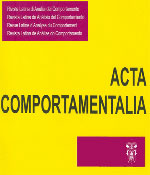L´ adaptation au temps chez l´ animal
Contenido principal del artículo
Resumen
Ce texte présente et discute la psychologie du temps chez I'animal, telle qu'elle est étudiée avec les procédures operantes. Une bréve introduction définit le champ analysé par rapport a la chronobiologie. L'exposé succinct des méthodes est complété par une synthése des données obtenues essentiellment avec les programmes FI, DRL et de production de durée. Les paragraphes suivanats abordent les différences interspécifiques, des développments méthodologíques (peak procedure) permettant, en príncipe, d'accédéer plus aisément au mécanisme hypothétique du timer, les hypotbeses au sujet du fonctionnement, de la nature ou de la structre de ce mécanisme, la relation entre les régulations temporelles acquises et les rythmes biologiques et enfin la relation entre la performance etg l'áge des sujets. La conclusion plaide en faveur du développement d'une psychologie du temps intégrative, qui tienne compte des dimensions comparative et développementales des adaptations au temps et perrnette une mise à I'épreuve des modeles explicatifs proposés.
Detalles del artículo
Citas en Dimensions Service

<a rel="license" href="http://creativecommons.org/licenses/by-nc-sa/4.0/"><img alt="Licencia de Creative Commons" style="border-width:0" src="https://i.creativecommons.org/l/by-nc-sa/4.0/88x31.png" /></a><br />Este obra está bajo una <a rel="license" href="http://creativecommons.org/licenses/by-nc-sa/4.0/">licencia de Creative Commons Reconocimiento-NoComercial-CompartirIgual 4.0 Internacional</a>.
